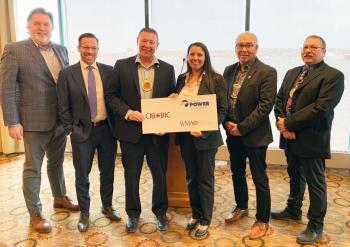Image Caption
Summary
Local Journalism Initiative Reporter
Windspeaker.com
The Canada Infrastructure Bank (CIB) announced in Halifax this morning that its first Indigenous Equity Initiative is an $18 million loan made to Wskijinu'k Mtmo'taqnuow Agency (WMA), an economic limited partnership owned by 13 Mi’kmaw communities in Nova Scotia.
WMA will work in partnership with Nova Scotia Power Inc. in the construction and deployment of energy storage facilities in the communities of White Rock, Bridgewater and Waverley. Nova Scotia Power is the recipient of $120.2 million from CIB for the project, which is still subject to regulatory approval.
Funding from CIB was crucial in allowing the Mi’kmaw Nations to participate in the project, says Crystal Nicholas, president and interim general manager of WMA.
“There's a lot of First Nations who have the ability to participate (in economic projects), but there's a lot that don't as well. So for the smaller First Nations, this is a huge opportunity and the fact that it benefits all 13 equally, that’s a huge deal,” said Nicholas.
Funding from CIB covers 90 per cent of the financing for the project. The other 10 per cent was accessed through a loan from Ulnooweg Development Group. That loan was made easier, says Nicholas, because of CIB’s commitment.
WMA was created in 2019 by the 13 Nova Scotia chiefs to develop partnerships with industry leaders in order to participate in opportunities that were happening in the province.
There’s power in the nations coming together as a united voice in order to go after projects, says Nicholas.
“We've been participating in many different sectors (and) we do have a few joint ventures that are operating right now, but this is the biggest project,” she said.
WMA also has a partnership with Natural Forces Development for two wind projects, Benjamins Mill and Westchester. Ground has broken on Benjamins Mill for construction of 28 turbines near Windsor, but not yet for the smaller Westchester project which will contain 12 turbines near Oxford. Both projects were approved by the Nova Scotia government in February 2023.
“Our relationship with Natural Forces was based on the rate-based procurement. So we got the $25 million from rate-based procurement for the Benjamins Mill project,” said Nicholas, who adds that it would have been advantageous to have worked with CIB on the financing for this project, too.
The rate-based procurement program was brought in by the province to assist it in achieving its 80 per cent renewable electricity standard by 2030.
CIB, a federal Crown corporation, didn’t get its corporate plan approved by Ottawa until November. The Indigenous Equity Initiative program was mandated in the 2023-24 federal budget.
CIB CEO Ehren Cory says discussions were happening for about a year with Indigenous communities that were expressing the “important desire” to have ownership stake in renewables and energy projects that were happening in their traditional territories.
“It’s also how the projects are going to get done,” said Cory.
As wind procurement projects in Nova Scotia were advancing faster if they had Indigenous ownership and WMA already had a track record and was in talks with Nova Scotia Power, supporting WMA with energy storage facilities was an easy first Initiative for CIB.
“(WMA was) aware what was happening with the CIB and that we had been given authority. They were ready to jump on the opportunity and I think just because we've had those ongoing relationships already that it really helped to move quickly,” said Hillary Thatcher, managing director of Initiatives with CIB.
An equity share in the joint venture with Nova Scotia Power will benefit both the partner Mi’kmaq nations and WMA, which will get a portion of the proceeds. The nations will determine how best to use those dollars, says Nicholas, as each community has unique needs.
Phased construction activities on the proposed project sites are planned to begin in 2024 and continue through 2026. The first site will be operational in 2025. These facilities will help reduce Nova Scotia Power’s greenhouse gas emissions by 98,000 tonnes annually.
Cory points out that unlike other loans, Indigenous communities won’t have to wait until they pay off their debt before they start seeing monetary benefits.
CIB requires 75 per cent of the proceeds to service its debt, while the remaining 25 per cent goes to the nations as an early return.
This loan, says Thatcher, is scheduled to be paid off in 15 years, but some flexibility does exist in that timeframe.
“This project was just the first one to go. It's not anywhere close to the last and we have more coming soon,” said Cory, who adds that Alberta, despite its six-month moratorium on green energy development, is very much in the mix.
CIB is involved in the financing of the ATCO partnership with Chiniki and Goodstoney First Nations in two separate solar power developments which received approval before the moratorium was enacted August 2023.
In that case, as CIB didn’t have its Indigenous Equity Initiative program operational, it provided a “low-cost loan, low-cost capital” to ATCO, which allowed ATCO to lend equity to the First Nations, says Thatcher.
“There is a lot of renewable development happening in Alberta. We're having lots of conversations and, I think, the government pausing, it's really just a reflection of how fast the renewable market has been growing in Alberta,” said Cory. “I think in the long run we will have lots of activity there.”
Thatcher expects CIB will be making announcements for renewable initiatives in Alberta over the next couple of months.
CIB has set a target of at least $1 billion to invest through its equity loan initiative to benefit Indigenous communities in Canada. The CIB’s $10 billion Clean Power priority sector addresses financing gaps in new projects such as renewables, district energy systems and energy storage.

